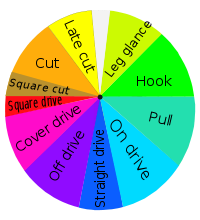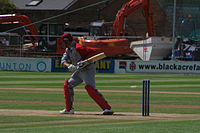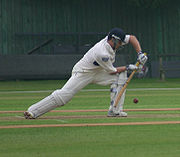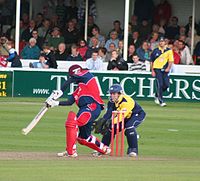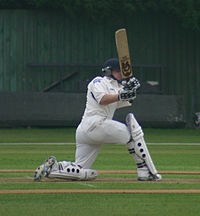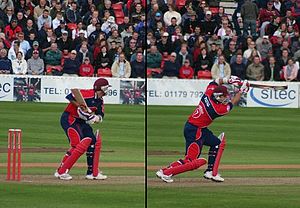- Batting (cricket)
-
The basics of batting.

 Andrew Strauss batting for England during the 2005 NatWest Series
Andrew Strauss batting for England during the 2005 NatWest Series
In the sport of cricket, batting is the act or skill of hitting the cricket ball with a cricket bat to score runs or prevent the loss of one's wicket. A player who is currently batting is denoted as a batsman, while the act of hitting the ball is called a shot or stroke. The terms batsman or specialist batsman are also used generically to describe players who specialise in batting (as opposed to e.g. bowlers who would specialise in bowling).
During an innings two batsmen from the team bat: the one facing the current delivery from the bowler is denoted the striker, while the other is the non-striker. When a batsman is out, he is replaced by a team mate. This process continues until the end of the innings, whereupon the other team gets a turn to bat.
Batting tactics and strategy vary depending on the type of match being played as well as the current state of play. The main concerns for the batsmen are not to lose their wicket and to score as many runs as quickly as possible. These objectives are generally in opposition to each other - to score quickly, some risky shots may need to be played thereby increasing the chances that the batsman will be dismissed. Depending on the current situation, batsmen may forgo attempts at run-scoring in an effort to preserve their wicket, or may attempt to score runs as quickly as possible with scant concern for the possibility of being dismissed.
As with all other cricket statistics, batting statistics and records are a major part of the game and provide a measure of a player's effectiveness. The main statistic for batting is the batting average, the mean score achieved by the batsman over his career. This is calculated by dividing the number of runs he has scored, not by the innings he has played, but by the number of times he has been dismissed. In limited overs cricket an additional important statistic is the strike rate, the rate at which a batsman scores his runs.
Due to the number of batting records he set, some as far back as the 1930s and still unbeaten, Sir Donald Bradman is widely regarded as the greatest batsman of all time. In the modern era, Sachin Tendulkar is widely regarded as one of the greatest batsman with the most number of Centuries both in the Test and Limited Overs format, most number of runs in the Test and Limited overs format, the highest score of 200 not out in One day cricket among other records.
Contents
Batting technique and strokeplay
Over time the development of cricket has led to a standard batting technique being used by most players in the game. Technique in this case refers to the batsman's stance before the ball is bowled as well as the movement of the hands, feet, head and body in the execution of a cricket stroke. Good technique is characterised by quickly getting into the correct position to play the shot, especially getting one's head and body in line with the ball, one's feet placed next to where the ball would bounce and then swinging the bat at the ball to make contact at the precise moment required for the particular stroke being played.
The actual movement of the batsman for a particular delivery depends on the shot being attempted. Front-foot shots are played with the weight on the front foot (left foot for a right-hander) and are usually played when the ball is pitched up to the batsman, while back-foot shots are played putting the weight onto the back foot, usually to bowling that is pitched short. Shots may also be described as vertical bat shots, in which the bat is swung vertically at the ball (e.g. when playing a drive or leg glance), or horizontal or cross-bat shots, in which the bat is swung horizontally at the ball (e.g. when playing the pull or cut shot).
While a batsman is not limited in where or how he may hit the ball, the development of good technique has gone hand in hand with the development of standard or orthodox cricket shots played to specific types of deliveries. These "textbook" shots are standard material found in many coaching manuals.
The advent of limited overs cricket, with its emphasis on rapid run-scoring, has led to increasing use of unorthodox shots to hit the ball into gaps where there are no fielders. Unorthodox shots are typically—but not always— more high-risk than orthodox shots due to some aspects of good batting technique being abandoned.
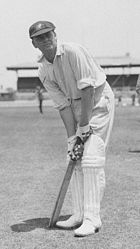 Bill Woodfull's stance.
Bill Woodfull's stance.
Stance
The stance is the position in which a batsman stands in order to have the ball bowled to him. An ideal stance is "comfortable relaxed and balanced," with the feet 40 cm apart, parallel and astride the crease. Additionally, the front shoulder should be pointing down the wicket, the head facing the bowler, the weight equally balanced and the bat near the back toe.[1]
Although this text-book, side-on stance is the most common, a few international batsmen, such as Shivnarine Chanderpaul, use an "open" or "square on" stance.
Leave and Defensive
The leave is sometimes considered a cricket shot, even though the batsman physically does not play at or interfere with the ball as it passes him. The leave is likely to be used by batsmen during the first few balls they receive, to give themselves time to judge the conditions of the pitch and the bowling before attempting to play a shot. Leaving a delivery is a matter of judgement and technique. The batsman still has to watch the ball closely to ensure that it will not hit him or the wicket; he also has to ensure that his bat and hands are kept out of the path of the ball so that it cannot make accidental contact and possibly lead to him being out caught.
A block stroke is usually a purely defensive stroke designed to stop the ball from hitting the wicket or the batsman's body. This shot has no strength behind it and is usually played with a light or "soft" bottom-hand grip and merely stops the ball moving towards the wicket. A block played on the front foot is known as a forward defensive, while that played on the back foot is known as a backward defensive. The application of these strokes may be used to score runs, by manipulating the block to move the ball into vacant portions of the infield, in which case a block becomes a "push". Pushing the ball is one of the more common ways batters manipulate the strike.
Leaving and blocking are employed much more often in first-class cricket, as there is no requirement to score runs as quickly as possible, thus allowing the batsman to choose which deliveries to play at.
Drive
A drive is a straight-batted shot, played by swinging the bat in a vertical arc through the line of the ball, hitting the ball in front of the batsman along the ground. Depending on the direction the ball travels, a drive can be a cover drive (struck towards the cover fielding position, an off drive (towards mid-off), straight drive (past the bowler and sometimes mid on), on drive (towards wide mid-on and mid wicket) or square drive (towards point). Drives can be played both off the front and the back foot, but back-foot drives are harder to force through the line of the ball.
Cut
A cut is a cross-batted shot played at a short-pitched ball, placing it wide on the off side. The batsman makes contact with the ball as it draws alongside or passes him and therefore requires virtually no effort on his part as he uses the bowler's pace to divert the ball. A square cut is a shot hit into the off side at near to 90 degrees from the wicket (towards point). A late cut, is played as or after the ball passes the batsman's body and is hit towards third man. The cut shot is typically played off the back foot, but is also sometimes played off the front foot against slower bowling. Apart from defensive technique, the cut is typically considered the most important stroke a batsman must master. The cut should be played with the face of the bat rolling over the ball to face the ground thus pushing the ball downwards. A mistimed cut with an open-faced bat (with the face of the bat facing the bowler) will generally lead to the ball rising in the air, giving a chance for the batsman to be caught. Though purists will generally go for the drive, the perfectly hit square cut is arguably the most beautiful shot in cricket.
Pull and hook
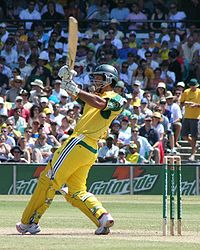 Ricky Ponting playing a pull shot.
Ricky Ponting playing a pull shot.
A pull is a cross-batted shot played to a ball bouncing around waist height by swinging the bat in a horizontal arc in front of the body, pulling it around to the leg side towards mid-wicket or square leg. The term hook shot is used when the shot is played against a ball bouncing at or above chest high to the batsman, the batsman thus "hooking" the ball around behind square leg, either along the ground or in the air. Pull and hook shots can be played off front or back foot, with back foot being more typical.
Leg glance
A leg glance is a delicate straight-batted shot played at a ball aimed slightly on the leg side, using the bat to flick the ball as it passes the batsman, and require some wrist work as well, deflecting towards the square leg or fine leg area. The stroke involves deflecting the bat-face towards the leg side at the last moment, head and body moving inside the line of the ball. This shot is played "off the toes, shins or hip". It is played off the front foot if the ball is pitched up at the toes or shin of the batsman, or off the back foot if the ball bounces at waist/hip height to the batsman.
Sweep
A sweep is a cross-batted front foot shot played to a low bouncing ball, usually from a slow bowler, by kneeling on one knee, bringing the head down in line with the ball and swinging the bat around in a horizontal arc near the pitch as the ball arrives, sweeping it around to the leg side, typically towards square leg or fine leg. Since a batsman is free to play any shot to any type of delivery as he wishes, the above list is by no means the only type of strokes that batsmen choose to play. Many unorthodox, typically high-risk, shots have been used throughout the history of the game. The advent of limited overs cricket has seen the increased use of unorthodox shots to hit the ball into gaps where there are no fielders placed. Unorthodox shots are rarely used in first-class cricket as there is commonly no need to score runs that quickly that would justify the extra risks taken.
A few unorthodox shots have gained enough popularity or notoriety to have been given their own names and entered common usage.
Reverse sweep
A reverse sweep is a cross-batted sweep shot played in the opposite direction to the standard sweep, thus instead of sweeping the ball to the leg side, it is swept to the off side, towards backward point or third man. The batsman may also swap his hands on the bat handle to make the stroke easier to execute. The batsman may also bring his back foot to the front therefore making it more like a traditional sweep. The advantage of a reverse sweep is that it effectively reverses the fielding positions and thus is very difficult to set a field to.
It was first regularly played in the 1970s by the Pakistani batsman Mushtaq Mohammad, though Mushtaq's brother Hanif Mohammad is sometimes credited as the inventor. Cricket coach Bob Woolmer has been credited with popularising the stroke.[2][3]
Andy Flower of Zimbabwe was a prolific and proficient executor of this stroke. Damien Martyn of Australia has been said to have "the most brutal reverse-sweep in the game". However nowadays the finest stroke maker of reverse sweep is New Zealand's wicket keeper Brendon McCullum.[4]
The most famous example of a reverse sweep backfiring was in the case of Mike Gatting of England against Allan Border of Australia in the 1987 Cricket World Cup final. With England on course for victory Gatting attempted a reverse sweep off the first delivery bowled by Border, top-edged the ball and was caught by wicket-keeper Greg Dyer. England subsequently lost momentum and eventually lost the match.
Because of the unorthodox nature of hand and body position, it is often difficult to get a lot of power behind a reverse sweep; in many situations, the intention is to glance or cut the ball to the backward leg area. However, in rare occasions, players have been able to execute reverse sweeps for a six. Kevin Pietersen, who pioneered switch hitting is adept at this, but one could argue that the resulting shot is basically a sweep rather than a reverse sweep. A more 'classic example' of such a shot would be Yusuf Pathan's six off of Robin Peterson.[5]
Slog and slog sweep
A slog is a powerful pull shot played over mid-wicket, usually hit in the air in an attempt to score a six. A shot would be described as a slog when it is typically played at a delivery that would not ordinarily be pulled. A slog is also called a cow shot or "cow corner". The slog is an effective shot because all the batsman's power and body weight can be put into swinging the bat at the ball.
A slog sweep is a slog played from the kneeling position used to sweep. Slog sweeps are usually directed over square-leg rather than to mid-wicket. It is almost exclusively used against reasonably full-pitched balls from slow bowlers, as only then does the batsman have time to sight the length and adopt the kneeling position required for the slog sweep. The front leg of the shot is usually placed wider outside leg stump to allow for a full swing of the bat.
Switch hit
A switch hit is a shot pioneered by Kevin Pietersen in 2008, and first used during the New Zealand series in England in 2008. In this shot, a batsman changes his handedness and posture to adopt a stance the mirror image of his traditional handedness while the bowler is running in to bowl. As a fielding team cannot manoevre fielders while the bowler is in his run-up, the fielding side is effectively wrong-footed with the fielders out of position. The legality of such a ploy was questioned during the series but the shot was cleared by the International Cricket Council as legal. The shot is risky because a batsman is less proficient in the other handedness and is more likely to make a mistake in the execution of his shot.
Scoop
A "scoop" shot (also known as Paddle scoop or Marillier shot or Dilscoop) has been used by a number of first-class batsmen, the first being Douglas Marillier. Firstly used in international match by Sri Lankan batsman Tillekartne Dilshan (with great success).This shot is famous in India by the name of Pallu Scoop.Another version of the scoop is the Super scoop which has been popularised by Bangladeshi skipper Shakib Al Hasan
It is played to short pitched straight ball that would traditionally be defended or, more aggressively, pulled to the leg side — both shots "off the back foot". To play a scoop shot, the batsman is on the front foot and aims to get beneath the bounce of the ball and hit it directly behind the stumps, up and over the wicket keeper. This shot, though risky in the execution, has the advantage of being aimed at a section of the field where a fielder is very rarely placed — particularly in Twenty20 and ODI cricket where the number of outfielders is limited.
Straight bat
Straight bat is the position of the bat, after it is driven and when the bat is perpendicular to the ground at the point of impact with the ball so that the batsmen can play the ball along the ground. The upper hand is used to achieve this.when the bat is straight the elbow should be raised so the it is at the same angle of the bat
Strategy of batting
Strategies vary between the three forms of international cricket, T20, Test cricket and One Day International cricket.
One-day international cricket
As One Day International matches have a limited set of overs, batsmen try to score quickly. Scoring quickly means trying to score at least one run per ball bowled. Most batsmen manage to score at an average of four runs an over (i.e. four runs in the six ball over).
When a team goes out to bat, the best players bat first. The first three batsmen (number 1, 2, 3) are known as the top order; the next four (numbers 4, 5, 6 and possibly 7) form the middle order, and the last four (numbers 8, 9, 10 and 11) are the lower order or tail.
The specialist batsmen of a team usually bat near the top of the order, so as to score more runs. The openers or opening batsmen are the first two batsmen to take the crease. They are not necessarily the best batsmen, but are expected to negotiate the new ball and not lose wickets until the shine on the ball is considerably diminished (a hard and shiny ball bounces and swings more and is more difficult for the batsmen to face). In addition, they are supposed to play a quick innings (more runs in fewer balls), reflecting the fact that the fielding side is subject to restrictions on the placement of fielders in the first 15 overs which makes it easier to score runs. In a recent amendment [1] to the rules of ODI cricket, fielding captains are given mandatory fielding restrictions for the first 10 overs and then two chunks of 5 overs each, also known as power-play overs, which they may impose at any stage of their choice within the stipulated 50 overs.
Following the openers is the No. 3 or one-drop batsman. His job is to take over from the openers and typically play a careful and prolonged innings, effectively tying up one end of the batting. This brings in some stability in the batting, as new batsmen find it difficult to settle down and it helps to have a settled batsman at the other end. The best batsman of the team is usually put at number 3 or 4, to protect him from the difficulties of batting against the best bowlers on a fresh pitch and to allow him to play a long innings.
The middle order is often considered the most valuable asset of a batting line-up in One-Day Internationals, because its members are responsible for consolidating the batting team's position through the middle part of the 50 overs. Characteristic of middle-order batting is the practice of taking many singles (or ones) and 'twos', with only the occasional boundary (a four or a six), as opposed to the more flamboyant openers who score primarily in boundaries. This is because the fielding restrictions on the opposition are lifted in the middle overs, so that the percentage of boundaries scored decreases. Middle-order batsmen are often chosen for the ability to run hard and fast between the wickets (to maximise the number of runs not scored from boundaries) and for their endurance and patience. The middle order typically sets the stage for an aggressive assault on the bowling in the final 10 overs of the match. To achieve this assault, two things are necessary - a number of hard-hitting batsmen yet to bat or not out and a number of wickets in hand (since aggression means a greater likelihood of losing wickets). The last 10 overs of a one-day cricket match innings is often the most exciting part of the innings, because of the large number of boundaries scored and wickets taken. During the last ten overs of an ODI, batsmen often use shots that are riskier than shots played at the beginning of the innings.
Examples of risky shots include the reverse sweep and the paddle-scoop. These shots are used to achieve a boundary which would not be possible when playing a safer, more orthodox shot. Finally, the lower order consists of the bowlers of the team, who are not known for their batting prowess and so bat as low down the order as possible.
However, there are no real restrictions to the batting positions. Captains have been known to experiment with the batting line-up to gain specific advantages. For example, a lower-order batsman is sometimes sent in at number 3 with instructions to pinch-hit (playing aggressively in an attempt to score more runs in fewer balls - a term borrowed from baseball) to score quick runs and shield better players, as his wicket (as a less accomplished lower-order batsman) is less valuable anyway.
Test cricket
In Test cricket, the usual aim is to score as high a total as possible. As the overs are unlimited, a batsman can take his time to score runs. In general, 90 overs have to be bowled per day in Test match cricket. The openers or the starting batsmen in Test cricket are often chosen for their sound technique and ability to defend their wicket, because the first 1–2 hours of an innings, especially if it begins in the morning, are usually characterised by good conditions for bowling, specifically in terms of the pace and bounce of the pitch and the lateral movement of the ball in the air.
The one-drop batsman is usually also chosen for his sound technique, so as to stabilise his end in case an opener gets out. The middle order of a batting team in Test matches usually includes its most skilled batsmen in terms of shot-playing ability, because during the middle overs of a day batting is relatively easier than in the initial stages of the innings. If the batting innings of a team begins after the last half hour of the day, the team might employ a nightwatchman to bat after a batsman gets out.
The nightwatchman is usually a lower-order batsman, able to protect his wicket primarily by defending dangerous balls and leaving non-dangerous ones rather than looking to produce a large number of runs for his team, but not a complete rabbit, liable to expose other batsmen late in a day. This move prevents a regular batsman from having to face the last few overs left in the day or bat early the following morning; however, some teams do not employ a nightwatchmen for various reasons, including a belief that middle-order batsmen should be able to protect their wicket in poor conditions as well as good, or a lack of defensively minded lower-order batsmen.
In the third innings, the batting team may score quickly to set a large target to the opposition. This scenario usually occurs on the fourth day's play. The batting captain decides how many overs he is prepared to allow the opposition to chase his total in their fourth innings. He usually declares his team's innings at a predetermined time on the fourth day so that the he can bowl at least 20 overs on that day and 90 overs on the last day. A good number of overs to bowl at the opposition team in the fourth innings is essential because usually on the fourth and fifth days of a Test match conditions are good for bowling (especially slow bowling), with the pitch having experienced a fair degree of wear and tear. Thus, to make the target as difficult as possible, the batting side speeds up the run rate (runs per over) till the captain declares.
If, however, a batting team is significantly behind the opposition in terms of runs going into the fourth day of a Test match, typical strategy by the batting team involves playing defensively to avoid losing their wickets. This ensures that they occupy the most time until the match draws to a close on the fifth day, because if a team's innings does not end on the fifth day then the match is drawn, or a stalemate is reached. However, in trying to do so, if the said batting team manages to overhaul its deficit and gain a substantial lead (an excess of runs) over the opposition, the captain may consider declaring the innings so that he can "force" a victory on the final day, depending on the size of his lead, the readiness of his bowlers, and the state of the pitch.
See also
References
- ^ Cricket: A guide book for teachers, coaches and players (Wellington: New Zealand Government Printer, 1984), p. 8.
- ^ Bob Woolmer | Obituaries | Guardian Unlimited
- ^ Latest Cricket News » Bob Woolmer, the `computer coach`
- ^ Cricinfo - Players and Officials - Damien Martyn
- ^ Yusuf Pathan Reverse Sweep Six
Cricket positions Fielding Side Batting Side Batsman · Batting order · RunnerOthers Non-players Categories:- Batting (cricket)
- Cricket terminology
- Cricket
Wikimedia Foundation. 2010.

